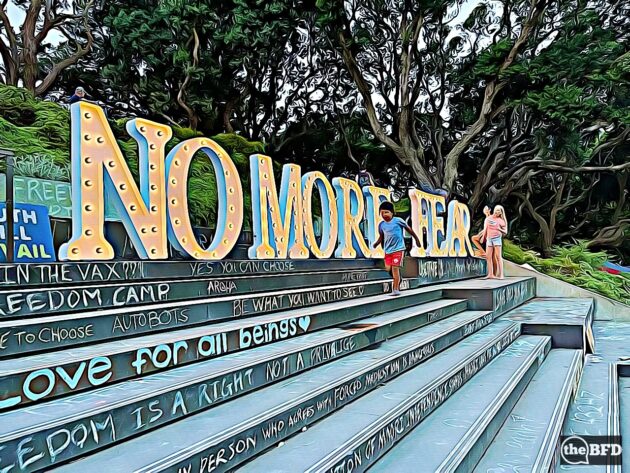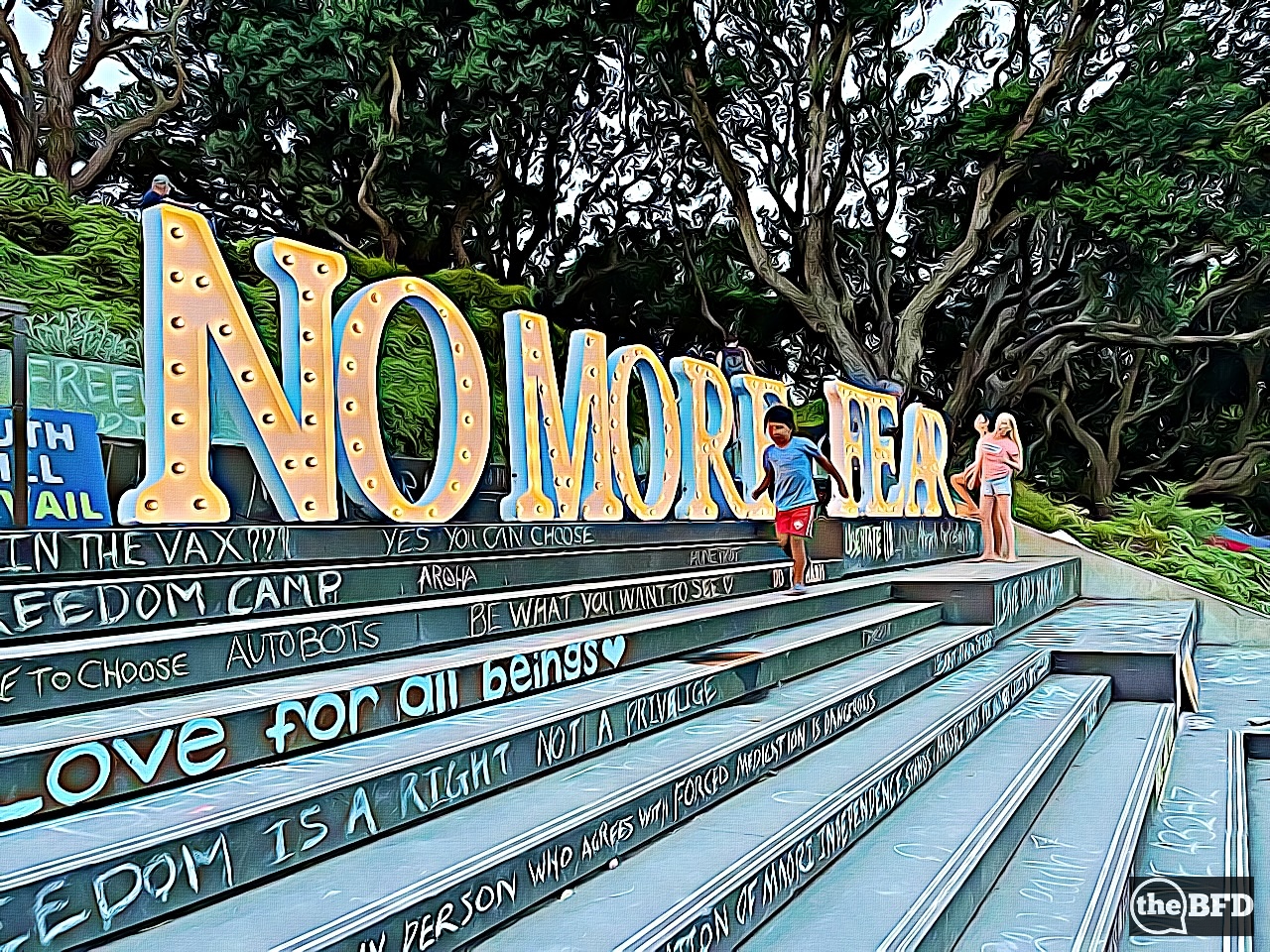Camp Freedom would never be able to survive the onslaught of what was coming - that much was certain. The question was: would it break them, or would they rise again like a phoenix, reinvigorated by the knowledge of the injustices that were surely going to be wrought upon them.
The Parlermaid
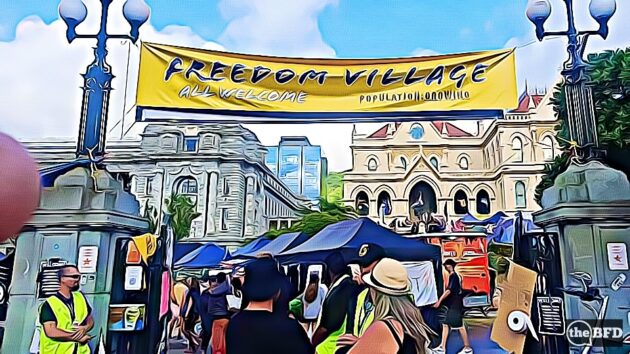
The shocking scenes depicted on mobile and computer screens around New Zealand on Black Wednesday, 2nd of March 2022, streaming from the vicinity of Parliament House have been hailed as a great victory by the Left. But was it really? I’m not so sure.
New Zealand’s centre-right conservative voters have always had one failing: they have historically been polite upstanding citizens to a fault. While BLM raged, looting and burning across the USA, American conservatives took to social media to condemn the actions of the movement as dangerously criminal. But still, the fires burned.
When the same movement came to New Zealand and coordinated a massive march through New Zealand’s streets, citizens on the Left walked the streets with slogans demanding the defunding of Police and shouting loud condemnation of Police brutality. They were supported in their march by Police escorts. George Floyd, a known drug dealer and notoriously violent towards women, was a hero to them. His death gave them the opportunity to have a cause to protest in New Zealand.
The right sneered their contempt from the safety of social media. And that, right there, has always been their failing. There is no danger arising from a simple sneer and social media is not a political stronghold. It has always been a media platform. The real work is done in real life. Out there.
For two years the centre-right watched ‘Ardernistan’ creep ever closer under the cover of Covid-19. Finally, the unjustifiable job losses, the deaths and the massive injuries suffered by thousands of everyday kiwis at the hands of a dictatorial Prime Minister – without any deference to their enshrined in Covenants that New Zealand has been a signatory to for decades – were enough to wake the centre-right out of its dozy slumber.
It started with a convoy, albeit a convoy with no Rubber Duck at the lead (the ducks come later in the story) and only a handful of trucks. Mainly it was suburban vehicles, utes, city hoppers, and the odd puddle jumper. But the spirit was there. Lots of spirit. It seemed a great way to show the Beehive the stuff that kiwis were made of.
Kiwis turned out in their hundreds of thousands across New Zealand. If not attending in the convoy, they lined the highways, city streets, and overpasses: madly cheering and screaming their delight that at last, it seemed we had a plan. They shared imagery of lines of traffic and waving flags over social media, flooding it with patriotism and pride.
It was rather unfortunate that when the convoy arrived at Parliament, it transpired that no plan had been made for what the convoy would do when it reached its destination. But in true kiwi style, all those drivers made do and arranged for their crews to be fed, watered, and housed in tents hurriedly brought into Parliament Grounds – and an occupation was born.
Again, the hurrahs from New Zealand’s disenfranchised and exhausted population were immense. Quickly rallying around – the same way our aunties did when there was a death on the street or a natural disaster that needed scones and sandwiches for the rescue team – and before the political elite could blink, the occupiers were set to reside among the trees on Parliament Grounds for months should the need arise.
Millions were raised, with individuals and businesses chipping in from all over New Zealand to ensure that these brave, bedraggled occupiers would want for nothing. The response was tremendous to behold.
Eventually, a leadership of sorts was created with a weaving of 7 or 8 different groups into an informal council for the occupation. The unofficial Occupation Council became the liaison for food trucks, power sources, security, communications, press releases through alternative media, and a demand made to Prime Minister Ardern.
“Come out of your ivory tower!” they said. “Talk to us, hear us, know our pain!”
At times the message was somewhat muddled, as happens when for years your supporters are accustomed to relying on social media as their daily information network. Sometimes it was difficult to understand if the message was that the occupiers wanted the vaccination orders revoked, the entire Public Health Response Act revoked, or the resignation of Ardern. Maybe it was all three.
Regardless of the ultimate goal of the occupation, Jacinda Ardern very quickly made her opposing position clear: these people were rabble. They were opposing her, and therefore they had no legitimate grievance to make.

She won by default, simply by refusing to do what was demanded of her. She, and she alone, decides what is right for New Zealand. She point blank refused to come out and talk to the protesters.
Her excuse? Someone had written “hang ’em high!” in chalk on the forecourt of Parliament House; thus there was, in her calculating mind, a threat that she could portray as being of incredible magnitude: the murder of politicians.
It became the go-to for all mainstream media coverage from that moment on. Never mind that it was a reference to the Nuremberg trials and the use of medical experimentation by Hitler’s Nazi regime – now mirrored in the Ardern regime in New Zealand. Never mind that it was a silly chalk reference that did not evidence a genuine threat from anyone. Never mind that it was written in hippy font, with love hearts and a smiley face underneath it. Jacinda had her excuse to turn her back on hundreds of thousands of kiwis, and she held onto it like it was a diamond-encrusted crown jewel.
Her pet media, taking their cue from their beloved ‘mutter’ (German for ‘mother’), began their misinformation and disinformation campaigns with great relish. They had a reason to begin their own sneer right back in the faces of the working class, soon to be known as the “river of filth” in front of Parliament. The contempt from New Zealand’s elites could not have been more on display had they held court and begun throwing the protesters to rabid dogs as sport.
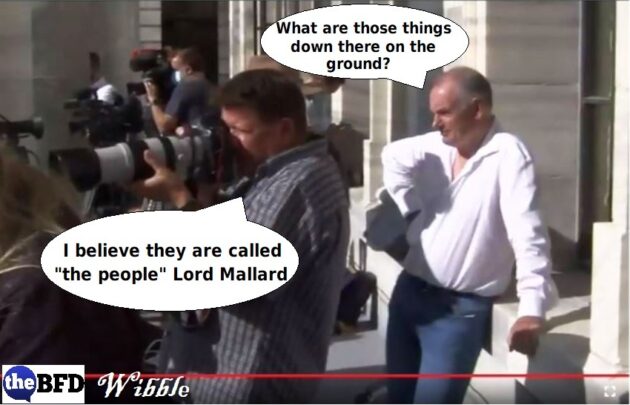
Within a day or two, Police were instructed by the Speaker of the House – confused about the extent of both his popularity and his legal position – to remove the rabble from his forecourt and garden. Police were instructed to issue trespass notices to the occupiers and clear them by force if necessary.
Let’s be clear about the Speaker’s position. He has sole jurisdiction over Parliament Grounds. He, and he alone, determines all matters in relation to Parliament property. But he is also somewhat hampered by his position. As a Labour and list MP, Mallard must of necessity exercise great caution if he is to make decisions about the occupation. If it were to be shown that he used his position in order to either advance his leader’s political position or silence her critics, then he would be on dangerous ground, no pun intended.
Declaring Parliament Grounds shut to the public as a means to give authority to the order to trespass the occupiers, flew in the face of two very important functions of the Bill of Rights Act.
Firstly, it denied the public access to Parliament Grounds for no reason other than to make it unlawful to be there.
Second, it breached the fundamental right of the citizens of New Zealand to peacefully assemble on public property in order to air their grievances against the government’s harsh and unjustifiable restrictions on their right to work and have bodily autonomy.
Had Mallard been a better politician (and human) he would have chosen his actions with far more care.
Police quickly moved to obey the bidding of the Speaker on Thursday the 10th of February. Around New Zealand, kiwis watched in growing horror as Police moved against the ‘trespassers’ with undeniably excessive force.
They were caught on live-streaming mobile phones circling the occupiers and trying to herd them into a group before launching an offensive and dragging them unceremoniously and violently out of the group to be thrown on the ground, manhandled, battered and arrested.
Women and children were among the victims – a major loss for the credibility of Police. There were numerous injuries – among them a broken sternum – and screen grabs of Police putting full body weight on the head of a 17-year old youth, circulated alongside footage of a young woman dragged naked and flung to the ground with such force it appeared she had been knocked unconscious.
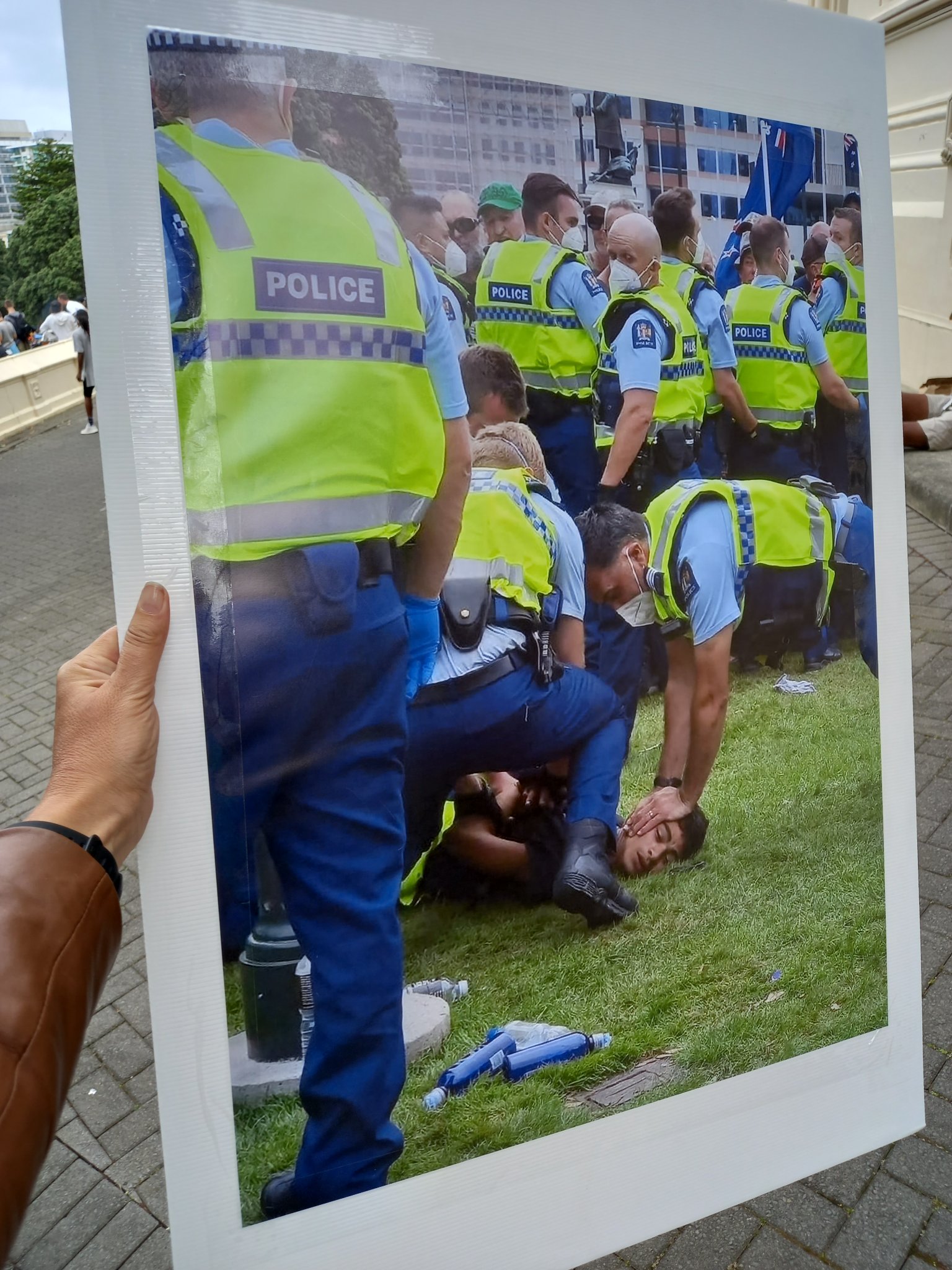
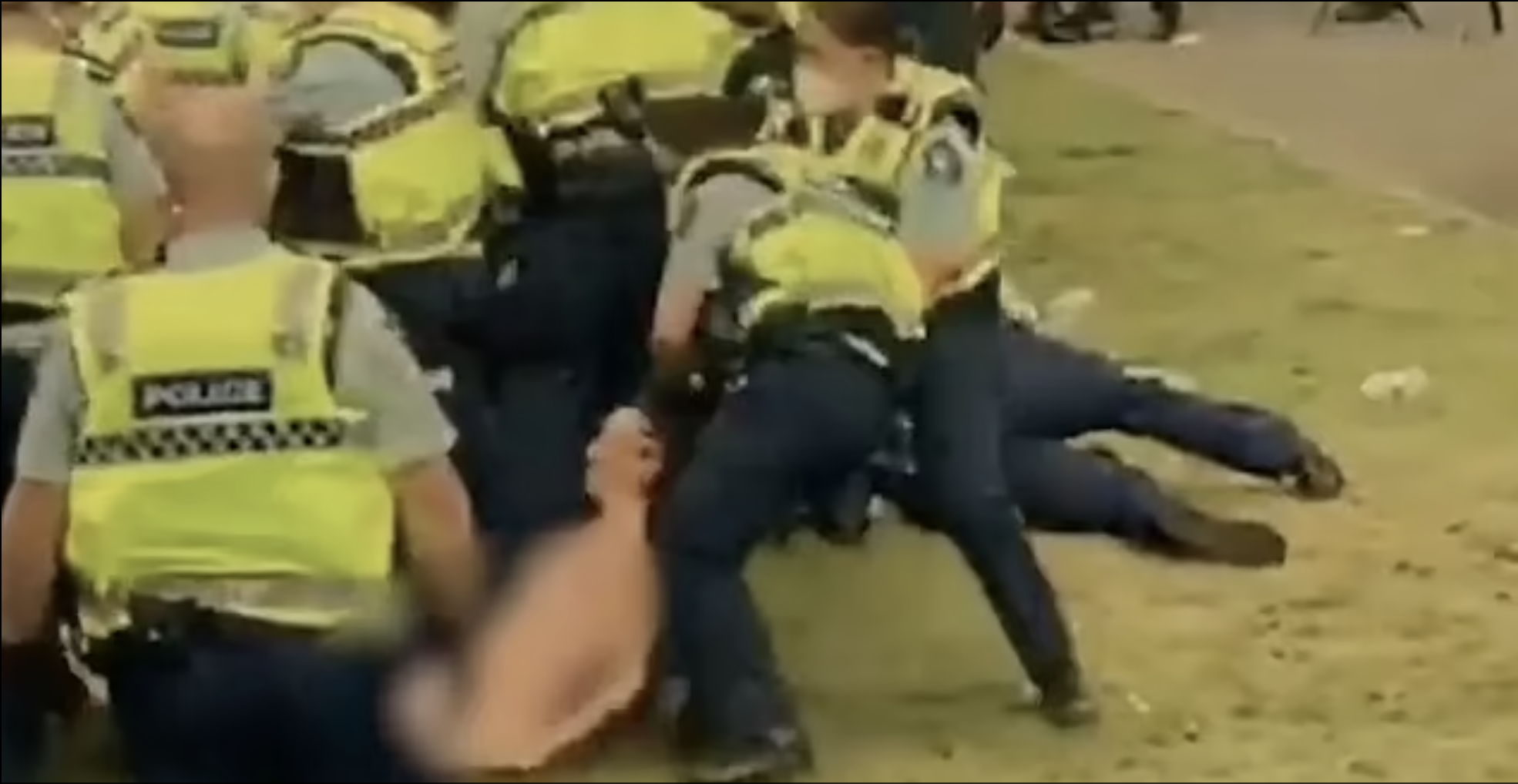
Pepper spray victims were viewed with such disgust at the overreach displayed by New Zealand Police that before long there were calls for the resignation of Police Commissioner Andrew Coster.
Amid howls of pain from protesters, a collective outcry from the public, and the live-streamed tears of fear from traumatised children watching their mothers dragged away by overbearing police officers, even members of New Zealand’s Police force spoke out (and resigned) at the sights witnessed that day.
Police eventually lost the battle and retreated at the end of the day leaving both sides exhausted, but the occupiers remained. And after seeing what had happened that day, their numbers grew by the thousands. Mallard’s plan had not only failed in spectacular fashion: it had backfired and served only to strengthen the position of the “rabble”.
By Friday night, it was clear to everyone that reinforcements were incoming to the occupiers newly nicknamed “Camp Freedom“. Kiwis came in their thousands to congratulate, to contribute, and to soak in the rich environment of freedom that had been established at Parliament Grounds.
No one wore masks, many were unvaccinated but not excluded, hugs freely given and received as essential human contact that had been missing for so long were met with tears of relief and joy.
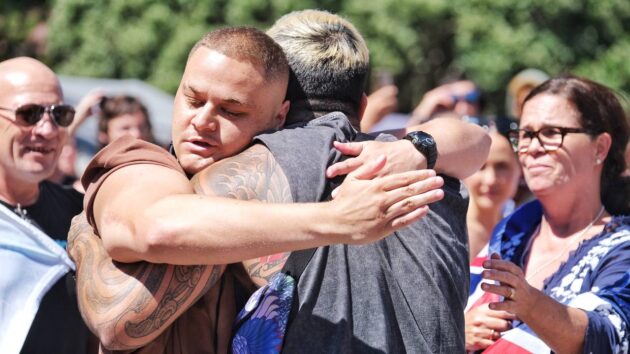
Young men and women walked in and around the grounds carrying signs offering free hugs to anyone who needed them. Nanas met newcomers at the gate with bowls of fruit and cookies, telling them where all of the facilities could be found and what sights were there to visit.
Arriving late on Friday night, I was overwhelmed with the welcome I received and the blatant displays of love for their fellow man that the occupiers used to obliterate the hate and fear that Thursday’s trauma had left behind.
Mallard was furious that his plan had backfired: that much was obvious. Friday the 11th of February brought with it not just a fresh influx of protesters to bolster the spirits and supplies of the occupiers, but also the clear and undeniable evidence of the malice in Speaker Mallard’s attitude towards the protesters.
Late Friday night, when most were peacefully sleeping in their tents, Mallard instructed that the sprinkler systems on the lawns of Parliament Grounds were to be turned on and left running overnight. He also installed a loudspeaker system in Parliament House and set about ensuring that none of the people on his lawn could possibly sleep.

The children woke suddenly in the dead of night to find themselves drenched through. Outside a cyclone was moving across New Zealand, bringing to Wellington heavy rain and howling winds. Inside, sprinklers activated by the Speaker of the House appeared under and around the tents where the children had slept, spraying water through flimsy material and soaking them.
Mothers rushed to their children, while plumbers among the men of the camp quickly devised a plan to divert the water flow away from the tents. Digging channels to provide a pathway to the stormwater drains, and using duct tape and old drink bottles as makeshift plumbing products, the camp was spared from the full extent of Mallard’s spite, but much damage was already done. In the rush to divert the water as much as possible, the ground beneath their feet quickly became an enormous mud puddle.
By the early hours of the morning, Mallard’s Twitter followers, at his request, had provided a ‘playlist’ to be used by the loudspeaker system he had installed and the occupiers were subjected to an endless round of Frozen’s ‘Let It Go’, the ‘Macarena’, and ‘Baby Shark’.
Not to be put off easily, the protesters (and now their new visitors as well) decided that there was in fact no real issue with the music Ardern’s government was providing. Amid jokes about Ardern’s boyfriend Clarke being the childish DJ and squeals of delight from newly unemployed Kindy teachers on the front line who genuinely enjoyed this music, the protesters began to line up and join in!
I stood among them, in the bucketing down Wellington cyclone-enhanced rain, beaming from ear to ear as I watched my friend (an ECE teacher) try to teach the hand dance for Baby Shark to a line of watchful Police and dance joyously to Let It Go from beneath her improvised rain poncho.
I had never been so proud of the resilience and downright ‘kiwi-ness’ of my fellow citizens as I was in that moment. I laughed, I cried, and I rejoiced that at long last it seemed that the centre-right was rising up and taking back its power after so long being down-trodden by an arrogant Left. The Autonomous Zone was the safe space. Camp Freedom was truly free.
On Saturday morning, farmers around the Wellington region arrived with bales of hay to spread across the grounds of Parliament to minimise the mud traipsed about among dancing and singing crowds. Plumbing and drainage equipment formed more permanent solutions, and the sight of plastic bottles as makeshift drainage began to recede.

A huge puddle that couldn’t be drained was aptly named Lake Mallard, and complete with decoy ducks and rubber ducks for the children to play with, that puddle became a symbol of the middle finger salute to the Speaker.
Children played in fresh water from the sprinklers under the watchful eye of newly appointed aunties and grandmas carrying prettily decorated brollies, and still the people danced and sang.
For hours in the rain, they danced and sang, some of them beginning to lose their voices with their exuberance. It was estimated that over that weekend, more than 8000 people travelled from all over New Zealand to witness this sight for themselves. Most left on Sunday renewed in spirit and mind, to return to lives made far more bearable in the knowledge that we the people had overcome evil with good. They returned to the partners and friends who had held down the fort in the regions with tales of freedom, passion, humanity, and hope.
The following weekend brought 15,000 visitors to the occupation site, and new camps in Auckland, Christchurch, and Picton had been set up. The movement was growing all over the country.
There are only a handful of reasons that the occupiers at Camp Freedom could genuinely be trespassed from Parliament Grounds.
- If it was no longer a “peaceful assembly” (thus removing their rights under the Bill of Rights Act).
- If they were a threat to their own or public health.
- If they were a threat to public safety or a nuisance to the public.
Seizing upon these reasons became the focus of the disinformation campaigns that were to come.
Ardern’s paid mainstream media shills, supported by taxpayer funding, set about ensuring that over the next few weeks these reasons would be subtly promoted to the general public of New Zealand, so that when the time came for Mallard and the Police Commissioner to act by force, as seemed inevitable, there would be enough support from the public to stomach it.
The protesters were referred to as violent, with young, white, middle-class Labour MP’s sending out tweets about being threatened with kidnap and death.
There was talk of nooses. The Police complained about facing abuse and assault by protesters, and a myriad of other make-believe tales were told in Stuff and the NZ Herald – none of which included any actual evidence.
The campers were subjected to defamatory accusations that they were racist, Islamaphobic, white supremacist: all the usual Leftie garbage that is used to silence critics and dissenters.
There had been clashes, sure, but they were all instigated by Police. There had been noise and late-night dancing, but the Speaker himself had also contributed to that.
There was a huge Maori contingent who began to form lines before the forecourt of Parliament House and proffer the haka in protest at being called white supremacists.
The Left were too obvious with their lies, but still, there was a growing concern among the general public. The protesters quickly realised they needed to be making their own record for the history books and hundreds of protesters took photographs and live-streamed Police violence against them.
Daily walkabouts on live stream showed the peace and harmony that the camp prevailed under. The visual of Police-initiated skirmishes and the odd use of excessive force however, spread faster than wildfire across social media and outraged the hundreds of thousands of protesters who could not be there but were checking in every day in support.
Politicians took to the floor with stories about filth and faeces in the camp, again with no evidence to back up their claims. The protesters were accused of putting their children’s health at risk by bringing them to a place where there was no sanitation and hygiene was poor.
Mallard’s excuse for turning on the sprinklers earlier was to say that he had seen a protester taking a dump on the lawn. No evidence of course – for the Left, just saying it is enough when you have complicit media to ensure that your story is the only one most people ever get to hear.
What Police and the political elite neglected to mention to Joe Public was that Police had purposely shut down every public toilet in the vicinity, told motels housing weekend protesters to stop accepting them (using Covid-19 vaccination policies), and begun to first prevent maintenance of, and then completely remove, the 30+ portable toilets (that the Occupation Council had arranged to be set up around the perimeter of the camp to ensure proper sanitation could be accessed readily).
Portable camp shower setups were reported as a desecration of the grounds. Fully legal mobile showers were stormed, smashed, and removed by a horde of Police – some wearing riot gear. Police and politicians, through the media, accused protesters of unsanitary conditions without bothering to mention that the protesters were being actively denied sanitation by those very Police and politicians.
The general public, gaslit by professionals, swallowed it hook, line, and sinker.
Media began to report accusations from ‘unnamed locals’ who claimed that they were being subjected to sexual assaults late at night, or were having their peace disturbed by the late night and early morning noise of the camp.
Stories abounded of workers having masks ripped off them, of young people on their way to school being verbally abused, and of businesses having to close because of abuse from the campers. All anonymous, all without evidence – all make-believe.
But again, the public were none the wiser to the tactics being used, why those particular tactics were employed, or what was to come.
Some of us saw the writing on the wall. Some, like me, had known from the outset what was likely to happen. Anyone who understands the political manoeuvring behind the scenes to put Ardern into her position in the first place, had a fair idea that those powers responsible for the rise of her dictatorship would not tolerate being undermined on the international stage by the filthy rabble at the opposite end of the political spectrum. The gloves would be off.
Every avenue for crushing the life out of the protest would be explored. Even better if it could be done in such a way as to leave them broken in spirit and deserted by the wider population to ensure that no more uprisings like it would happen again anytime soon.
Camp Freedom would never be able to survive the onslaught of what was coming: that much was certain. The question was: would it break them, or would they rise again like a phoenix, reinvigorated by the knowledge of the injustices that were surely going to be wrought upon them.
On the 2nd of March 2022, hell rained down upon the residents of Camp Freedom. Policemen came in their hundreds, some cadets from the Training College, some brought in from the regions; almost all of the Wellington contingent were in attendance.
The camp was warned that they would come and they prepared as best they could for the onslaught that they knew it would bring, but it wasn’t enough.
Using the ‘kettle’ technique to herd the protesters, Police forced them out from Parliament Grounds into the surrounding streets. Cadets and constables ripped through the campsite destroying everything that the protesters had used. Tents were torn down, canopies broken and flattened, tables smashed, computer equipment flung onto the ground and trampled.
Not content to simply remove the protesters, the video evidence suggests that the orders were to crush their efforts to ensure they could not quickly regroup and rise again from the ashes.
Police tore down tents and destroyed property on the grounds of the nearby church, where protesters had been given full permission to camp with the Diocese’s blessings, in a blatant disregard for fundamental property and occupancy law.
Police had no right to come onto the church grounds, let alone to try and trespass or remove anyone from them.
Once the crowds were mostly in the street, Police began to announce over loudhailers that they were now closing those public thoroughfares and anyone who remained there would be subject to arrest. Those who remained inside the Grounds, peacefully linking arms to try and prevent the hordes of Police from forcefully ejecting them, were subject to pepper spray and the use of shields and batons to beat them into submission.
Realising that an opportunity had arisen, people from outside the protest began arriving at Parliament Grounds. It is unclear whether they were supporters of the protest’s purpose, simply taking up an opportunity, or deliberately inciting violence to be used as media fodder. What is clear is that they had an entirely different agenda from that of the people of Camp Freedom.
Despite evidence from the multitude of live streams running on the day that the residents of the camp tried desperately to tell them not to, these new visitors took to apparent displays of trying to incite violence. They threw bottles at Police, used fire extinguishers to combat clouds of pepper spray, and called for the crowd to “fight, fight!” rather than peacefully resist. Shouts of “F**k the Police!” could be heard above the clamour of the crowds.
Police, in their haste to destroy everything they could, overturned a tent onto a hot petrol generator, and a small fire broke out. The fire could have been brought quickly under control had it not been for the interference of the agitators who had appeared on the scene. Video links show a number of hooded, gloved, and masked people, none of whom were recognised by the core protesters, deliberately adding fuel to the fire.
At one point it looked like one of them was tipping petrol onto it to further the rapid spread. Screenshots from live feeds show a hooded individual lighting a wooden flagpole and deliberately spreading the fire to neighbouring tents.
One young woman was caught on camera trying to set alight the hedges around Parliament House. She was quickly stopped by Chantelle Baker, daughter of Leighton Baker, when it became obvious how dangerous that would become for every person on the Grounds and inside Parliament buildings.
The protesters stood back in horror, screaming at the agitators to stop as their possessions were quickly consumed by flames, turning to leave the Grounds out of fear for their own safety when they realised how fast the now out-of-control fire would be likely to spread among the remainder of the tents.
The air became thick with black smoke as the fire spread, and any who were still trying to live stream what was happening were beginning to choke on the combined effects of pepper spray mist and smoke.
Small gas canisters used for camp stoves exploded, raising cheers among the newcomers. Parliament Grounds had become an opportunistic riot for outsiders in the midst of the chaos instigated by Police.
Over the next few hours, the crowds grew more rapidly, with new gangs of agitators arriving to dig up cobblestones from the surrounding streets and throw them at Police. It had become a battleground between Police and their natural enemies, as roving groups of obviously criminal temperament continued long after the protesters had given up ground.
The battle was still waging long enough to be a live scene on the evening news. By then most of the protesters had either dispersed or been boxed in and arrested, and the public was completely unaware that what they were witnessing was an entirely different group of people.
Within hours, social media feeds were full of disappointed, heartbroken, and emotionally shattered New Zealanders. Questions were being asked repeatedly about what had gone wrong. It was clear that even those sitting at home were in shock.
There was genuine fear for the whereabouts and wellbeing of people we knew on the ground in Wellington. There was anger, disgust, fear, despair and every emotion in between on full display on social media.
And then the Left began to gloat. And to virtue-signal. And that was almost enough to send Camp Freedom’s supporters over the edge and into hatred. Thankfully, by then everyone was heading to bed to rest and see what tomorrow would bring.
Tomorrow has now come, and now we look around us to see if there is anything worth salvaging in the aftermath of Black Wednesday. Can we survive? Can we rise up again and amass an army of peaceful warriors to reclaim our nation? I think we can.
I think that if we use our newfound organisational skills, combined with good planning and great strategic thinking, we can crush this evil into the ground once and for all.
Now is not the time to be thinking about who to vote for in this new politically homeless environment. Now is the time to be reminding whoever we vote for that we will not sit idly by and watch our nation be destroyed by their betrayal of their responsibility to do what is best for all New Zealanders.
There is only one place left to go. Back to Wellington. With tens of thousands more. Not to occupy. Just to show up, to say our piece, and to leave again. We should no longer have a goal of revoking the Covid-19 Public Health Response Act and its vaccination orders. That no longer goes far enough. It’s time for Jacinda Ardern to go.
And so I charge you with this challenge, my beautiful, brave, and countless friends – now is the time to march on Parliament.
Now is the time to walk, not drive. Not to ask our Prime Minister to step down, but simply to show her cabal and the entire world how many of us stand against her.
Not to find a new political home, but to remind all politicians that their careers and reputations are in our hands.
Now it is time to finish this thing. Will you do it?
